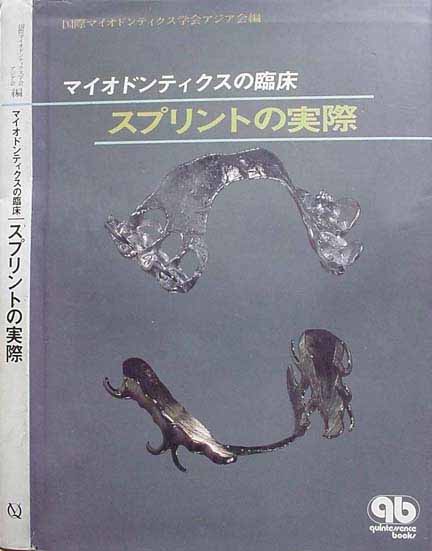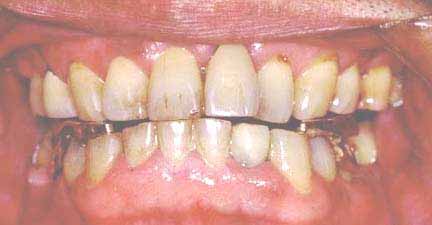
MMD WEDGES
Harry Cooperman DDS*
Noboro Miura DDS**
NOTE--The International Academy of Myodontics (IAM) has replaced the term of TMJ with a more descriptive term MANDIBLE MALPOSTURE DISORDER (MMD).
Since the National Institutes of Health Technical Assessment conference on TMJ ,April-May 1986 there has been no further published recommendations nor advanced methods for the treatments of the syndrome . The International Academy of Myodontics have embarked on a global research effort to decipher advanced medical-dental treatment procedures..
Eligibility of patients in this research (USA & JAPAN) Sufferers who have never been previously treated by any of the following:
a. Equilibration of the teeth
b. Bite Correction
c. Maxillary splint therapy
d. Mandibular splint therapy
e. Maxillary and Mandibular splint therapy
f. Selective tooth balancing
g. Night guards
h. Bite plates
i. Orthodontia
j. Tooth extractions
k. Muscle relaxants
l. Eating soft foods
m. Appliances to protect the joints
n. Tooth uprighting
o. Wisdom teeth extractions
p. Any tmj surgery
q. Glenoid fossa surgery
r. Pharmaceutical pain killers
s. Mandibular positioners
t. Hot packs
u. Cold packs
v. Mouth exercises
w. Jaw exercises
x. Relaxing exercises
y. Hypnosis
z. Meditation exercises
00. MMD/TMJ
The production of painful sensation is the organism's most important means for directing attention to body disharmony. The patients description of the location and the character of the pain is often incalculable value in diagnosis although there are times when deceptively referred pain leads to serious error. Alleviation of pain is often the physician's most significant contribution to the patient's comfort although there are times when premature and over enthusiastic use of analgesics has unfortunate consequences.
In general, painful stimuli are referred
to anatomic sites or to a hysiologic
dysfunction.
A committee selected by the National Institutes of Health, April-May 1996, declared that medical science is so unsure about how to treatTMJ that this syndrome has not been accurately diagnosed nor described--and no one is certain whether it should be treated by physicians or dentists or both.
"We are dealing with problems that
have no clear diagnosis" said
chairwoman Doctor Judith E.N. Albino of Colorado Health Science
Center in Denver (1)
Painful and non-painful MANDIBLE MALPOSTURE DISORDERS (MMD) includes symptoms ranging from aches and pains in the jaws ears and head, to dizziness, pain on chewing, limited ability to open and close the mouth , clicking and popping sounds,.
Patients spend a $1 billion a year on medical care and drugs for the treatment of the TMJ syndrome according to the National Institute of Health.
Historically TMJ was described by.B.Costen M.D. (1931) and has been recognized as a medical problem and no one is certain of treatment to this date.
Doctors Harry. Cooperman DDS (USA) and Noboru Miura DDS (Japan), researchers of the International Academy of Myodontics, have included the symptoms of MMD in this paper.
Their interest in a group of patients,
who suffered persistent or recurrent
manifestations of MMD was aroused by the finding of various degrees
of irritation of the covering tissues of the dorsum of the tongue
and uvula .
Suspecting that the underlying cause
of these irritating phenomena might
be postural, they demonstrated; first, that mandibular protrusion,
as seen in stone age skulls, was a natural protective mechanism
that functioned to
preserve head, throat and neck physiology occurring after cuspal
erosion of the teeth by attritional occlusion; second, that mandibular
retrusion, as
observed in their patients. causes the dorsum of the tongue and
the uvula to impinge on one another, thereby producing irritation
in the manner of
overlying toes or similar structures; third, that uvula impingement
appreciably narrows respiratory and alimentary pathways in the
oropharynx; fourth, that these impingements may produce anatomic
and
physiologic disturbances including pain, breathing, swallowing,
eustachian tube dysfunctions; fifth, that mandibular retrusion
in itself, may disturb MMD relationships as described by others;
and sixth, that recognition of the basic anatomy and physiology
mal-alignment of the mandible may permit the informed physician
and dentist to correct the malposture by mechanical measures.
When the publication of Cooperman et al, `Organic Tooth Wear--Overlooked in Anatomy Texts' appeared in Medical Hypotheses adjunctive truths were annexed to present day understandings concerning MMD.
Doctors Cooperman and Miura found the
conditions of Uvula Tongue
Malposture disorder in most of their research patients (Kaiser
Medical Center, Hawaii and Japan) 1980-1985). Uvula Tongue Malposture
is the rubbing together of the uvula against the dorsum ofthe
tongue. The space between the tongue and uvula is visiblei in
diagrams in anatomy texts. Texts consistently depict a space
between the uvula and the posterior surface of the tongue. This
space was absent in all the treated patients in practice and
research. Why has this missing natural organic toothwear never
been documented in normal occlusion?
Cooperman and Miura believe this new
appreciation, of stone ageman's
abrasive, sandy. unclean, uncooked. hard to chew, food diet,
created the
consequent tooth-crown wear.
This missing physiologic tooth attrition,via the abrasive primitive diet, is ta possible missing link to the diagnosis and effective method of treatment of MMD patients. Cooperman and Miurapostulate that as organic tooth-crown wear progressed in primitive man.the mandible and it's attachments became free of dental 'locking'of the teeth.
That,'text-book' interdigitation and
occlusion of the teeth restrained any
natural posture of the mandible.
The 'on the spot' immediate care and
non-invasive routine for stopping
painful and non-painful MMD were simultaneously developed at
Kaiser
Medical Center, Honolulu, Hawaii and in Tokyo, Japan (1980-1987).
Researched patient complaints of pain and non-pain MMD were:
Headaches
Tight Chest
Allergies
Face Pain
Tongue Pain
Shortness of Breath
Sleep Disorders
Emphysema
Wheezing
Bluish Nails or Lips
Bronchitis
Dizziness
Facial Paralysis
Post Nasal Drip
Tonsillitis
Ear Pain
Snapping TMJ
Stuffy Nose
Difficult Open Mouth
Stuffiness of Nose
Running Nose
Difficulty Breathing
Chronic Cough
Sinusitis
Jaw Pain
Snoring
Asthma
Speech Problems
Rapid Breath
Inflamed Tongue
Echoes of Voice
Bruxism
Popping of Ears
Numbness of Scalp
MMS/TMJD
Eye Pain
Change in Pitch of Voice
Tongue Biting
Throat Difficult to Clear
Excessive Saliva
Apneas
PREVIOUS DISAPPOINTING RECOMMENDED TREATMENTS BY MD/DDSNeckTraction
Ultra Sound
Blood Studies
Pain Killing Drugs
Sleeping Pills
Balancing Bite
Bite Raising
TMJD Appliances
Orthodontia
Jaw Repositioning
Dieting
Exercising
Psychiatry
Neurologists
Urine Testing
Muscle Relaxants
Tooth Removals
Craniopathy
Oral Nights Guards
Bite Correction
T.E.N.S.
Muscle Injections
Swimming
Tongue Restrictions
Diagnosis and treatments for MMD patients were made by Marcelo Obando M.D., Chief of Otolaryngology, Kaiser Medical Center, Honolulu, Hawaii in U.S.A. and a parallel MD and DDS team in Japan.
All patients were fitted with a pair
non-toxic temporary maxillary and
mandibular intra-oral "MMD Wedges" atop their remaining
teeth. None of the research patients were toothless. The wedges
were made of mouth
guard material in the HIP/ATTRITIONAL plane of occlusion. The
wedges
infringed and negated any freeway space, contained no interdigitating
occlusion, all theories of previous MMS therapy were discarded,
face-bows for mandibular alignment were never used. MMS wedges
are temporary non-invasive and reversible in this therapy.
Prior to our MMD approach all patients reported that they had been told, in one way or another, that, "Nothing further can be done", "Research is being done on your problem." and/or "You simply have to live with it."
However, when these patients (80) were
diagnosed and treated with our
MMD Wedges all reported significant improvement of their MMD
complaints. Many of the patients stated "I can breathe better."
"I sleep better" "I have more energy", "Most
of my problems are gone."
Anatomy and physiology texts describe
the gear-like apposition, of adult
upper and lower teeth, as normal in growth and development. By-passed
by academicians is the attritional wear of teeth that results
from man's stone age man's food diet. This tooth attrition, which
is not taught as a normal physiologic evolution has been overlooked.
Not recognized is that the presence of this tooth wear is nature's
wisdom and protection that functions to prevent MMD and other
future head and neck malpostures, preserve oral, pharyngeal and
breathing physiology throughout life.
As man removed grit, sand and other
abrasive food from his diet, he
deprived himself of a natural health aid, i.e., attritional wear
of teeth. In
contrast, the unworn teeth, characteristic of present day man,
prevent
anatomic and physiologic changes that normalize the pathways
of
breathing, deglutition, voice and other physiology. For these
reasons
textbook tooth occlusion should be re-evaluated.
The International Academy of Myodontics have adopted nature's attritional occlusion as the natural and normal dental occlusion rather than dentistry's present day concepts.
All dental examinations of IAM commence
with the establishment of the
HIP/ATTRITIONAL plane of occlusion on patient mounted casts.
Dental
engineering failures are instantly exposed and diagnosis of dental
requirements follow.
NOTE :
Dictionary Definition:
Disorder is:
A lack of order or regular arrangement.
Confusion An upset of health or function
Disarrangement
Disease is:
An abnormal condition of an organism or part, especially as a consequence of infection, inherent weakness, or environmental stress, that impairs normal physiological functioning. Lack of ease.
Which MMD are you about to have treated? Disease or Disorder?
If disorder: Dentist may treat.
If disease: physician/dentist may treat.
Photo of initial temporary MMD wedges are intra-orally portrayed:

